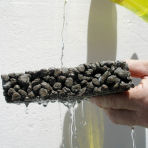August 4, 2007
by Jay Golden and Kamil Kaloush for the Arizona Republic

 In rapidly urbanizing regions such as Phoenix, pavements comprise the largest percentage of the developed urban fabric, more so than roofs and open space. During daytime, streets, highways and parking lots absorb and retain short-wave radiation from the sun.
In rapidly urbanizing regions such as Phoenix, pavements comprise the largest percentage of the developed urban fabric, more so than roofs and open space. During daytime, streets, highways and parking lots absorb and retain short-wave radiation from the sun.
At night, it slowly reradiates that heat back as long-wave radiation. It is one reason that nighttime temperatures in the Phoenix area are up to 15 degrees warmer than the adjacent desert region.
The resulting “Urban Heat Island Effect” not only makes the outdoors less comfortable, but also makes the urban environment less sustainable, contributing to increased human-health effects, electricity demands, water consumption and evaporation.
Engineers and scientists are looking into a new generation of paving materials and technologies to reduce the impact of the urban heat island. This includes new mixtures and surface treatments that can reduce surface temperatures.
One practical option available right now is the use of pervious – or porous – pavements. Pervious pavements can be designed and constructed using either portland cement or asphalt concrete materials. Such a surface was constructed earlier this year in the parking lot outside ASU's Nelson Fine Arts Center in Tempe.
 Pervious pavements contain less sand and greater porosity, which allows air and water to pass through its surface. This design provides a more-efficient platform to incorporate shade-bearing trees into parking and pedestrian pavements while minimizing the amount of land needed to construct parking lots.
Pervious pavements contain less sand and greater porosity, which allows air and water to pass through its surface. This design provides a more-efficient platform to incorporate shade-bearing trees into parking and pedestrian pavements while minimizing the amount of land needed to construct parking lots.
Pervious pavements “breathe” like natural soil. They enable trees and plants within or near parking lots better access to oxygen and nutrients from soils beneath the pavement while reducing the temperatures near the trees' root zone. As a result, trees grow faster and larger, providing more shade while increasing evapotranspiration.
Another form of pervious pavement seen in the Valley by residents is rubberized asphalt; it is about 1inch of friction-course material placed over existing pavement to reduce highway noise. This treatment also reduces surface-standing water, making the roadway safer when wet. At night, the pavement cools rapidly compared with non-pervious surfaces.
ASU researchers are working with local utilities and cities such as Phoenix, Chicago, and London and federal agencies such as the Environmental Protection Agency, Department of Energy, and the Centers for Disease Control to model and demonstrate how best to reduce the urban heat island through innovative pavement designs.
Advances in such materials and technology clearly are demonstrating environmental, aesthetic and practical benefits - not to mention long-term economic advantages, as cool pavements reduce cracking, resulting in lower maintenance costs.
The next big step requires government, industry and the business community to make a more concerted move toward more sustainable urban materials.
To learn more, visit: www.asusmart.com.
Jay Golden is an assistant professor in the School of Sustainability and affiliate in the Civil and Environmental Engineering Department at Arizona State University. He is also the Director of the National Center of Excellence on SMART (Sustainable Materials & Renewable Technologies) Innovations for Urban Climate and Energy. The Center's focus is on developing new materials and technologies to reduce negative impacts of the built environment on the urban climate and energy resources.
Kamil Kaloush is an associate professor in the Civil and Environmental Engineering Department as Arizona State University and is Co-Director of the National Center of Excellence on SMART Innovations. Dr. Kaloush is a licensed professional engineer.
This article is one in a series of articles contributed by Arizona State University's Global Institute of Sustainability. The Institute was established to catalyze and advance interdisciplinary research and education on environmental, economic and social sustainability.

